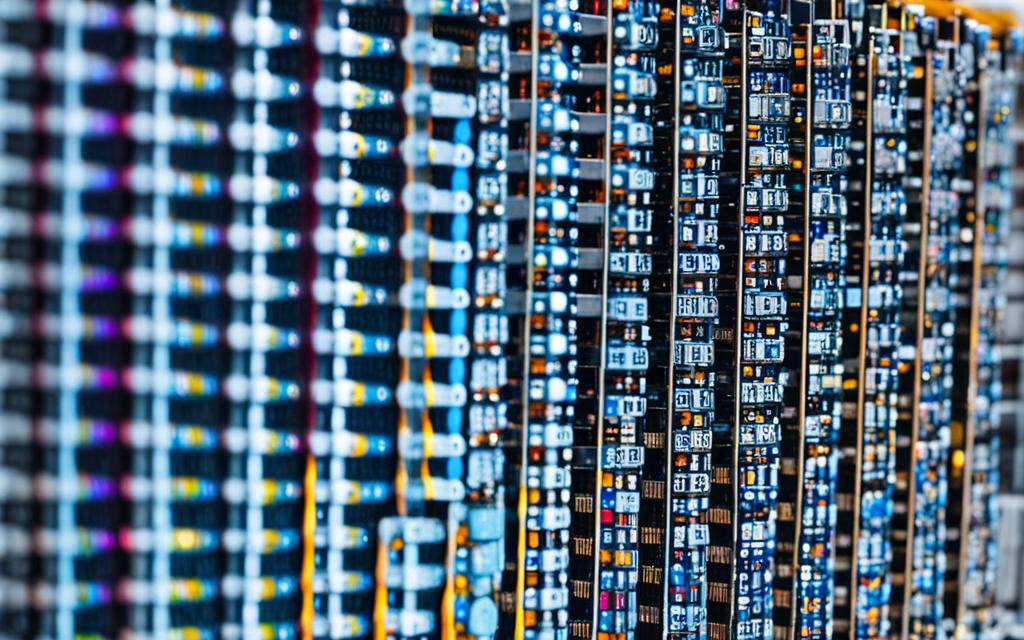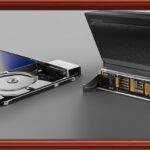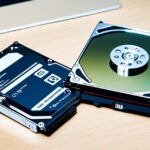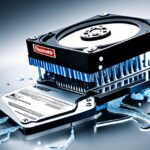Table of Contents
Understanding HDDs, or Hard Disk Drives, is key for anyone keen on data storage tech. These devices mark a milestone in the digital era, starting in 1956 with IBM’s innovation. Since then, over 224 companies have shaped HDD evolution, with Seagate, Toshiba, and Western Digital12 leading today. The HDD has become a go-to for storing data in the 21st century, proving its worth in many areas2
This piece sheds light on how HDDs keep vast data using cutting-edge tech, changing computing. We’ll look into the core mechanics of hard drives and their growth. This will give readers a full view of how they work.
Key Takeaways
- HDDs have been key in storing data since 1956.
- IBM led with the first HDD, inspiring future tech.
- Top manufacturers now lead in the HDD market.
- HDD storage is used widely across industries.
- Grasping HDD mechanics is vital to get data storage tech.
The Basics of Hard Disk Drives
To start understanding computer storage, knowing about HDDs is key. A Hard Disk Drive (HDD) is a storage tool that keeps data even when it’s turned off. It uses magnets on spinning disks to save info. Over 50 years, HDD sizes shrunk from two fridges to just 3.5 inches for desktops3 and 2.5 inches for laptops.
What Is an HDD?
An HDD is a device for keeping data using magnetic tech. It writes data on spinning disks called platters. These disks spin very fast, from 5,400 to 15,000 times a minute. This speed helps with saving and getting data quickly3. HDDs are now in many tech devices, proving their importance in today’s computing world.
Components of a Hard Disk Drive
The hard disk’s parts are vital for it to work well. Key components include:
- Platters: Circular disks where data is saved.
- Read/Write Heads: They read or write data on the disks.
- Spindle Motor: This spins the disks rapidly for data access.
- Actuator Arm: It moves the read/write heads to the correct spots.
These parts make HDDs reliable for storing data. Even with faster SSDs available, HDDs are chosen for their large storage at a lower cost. SSDs are faster and more robust, but HDDs are still used widely. To learn more about SSDs, have a look at this detailed guide.
How HDD Store Data
Hard Disk Drives (HDDs) are wonders of technology. They store a lot of information in a complex way. Data is stored using binary code. This is a basic language turning everything digital into 0s and 1s. It’s key to how data is kept and found in HDDs.
Binary Code: The Language of Hard Drives
Binary code is vital for storing data in HDDs. Each bit of information is carefully put onto the disk’s surface. It’s written as magnetic North or South. This shows the difference between stored bits. Since the first HDD, which held just 3.75 MB, the technology has grown massively4.
Magnetic Coating: The Secret Behind Storage
The magnetic coating on HDD platters is their secret. It lets the disk keep data using magnets. This makes them last long and reliable. They’ve evolved to fit laptops at 2.5 inches and desktops at 3.5 inches. This shows how much the technology has advanced3.
The Role of Read and Write Heads
The read and write heads are crucial. They float just over the platter. They use electromagnetic currents to read and write data. They don’t touch the disk, preventing damage. Traditional HDDs can spin from 5,400 to 15,000 rpm. This makes accessing data fast3.
| Feature | Description |
|---|---|
| Binary Code | Foundation for data storage, representing information as 0s and 1s. |
| Magnetic Coating | Enables HDDs to retain data with durability and longevity. |
| Read/Write Heads | Utilises electromagnetic currents for data operations while preventing damage. |
| Rotation Speed | Ranges from 5,400 to 15,000 revolutions per minute for varying performance. |
| Common Capacities | Range from 16 GB to over 20 TB. |
The Writing Process in HDDs
Exploring how hard disk drives (HDDs) manage data shines a light on their efficiency. At the heart of this process are the platters, spinning rapidly. This allows the write heads to store information effectively.
An electrical current powers the write heads, creating magnetic fields. These fields convert information into a physical format by indicating binary data. It’s a clever way to record and keep our data safe.
How Data is Written on Platters
Writing data to platters is a precise task. It happens when magnetic heads meet the spinning disks. These interactions create magnetised zones that stand for binary values.
Thanks to this special system, HDDs efficiently store data on their magnetic surfaces. They create lasting records that don’t need power to remain safe. This non-volatile storage is key to keeping data secure over time56.
The Significance of Magnetic Fields
Magnetic fields are crucial to HDDs’ operation. They do more than just write data; they also ensure its safety and longevity. Each pulse stands for a binary digit, forming a strong data preservation method.
This system allows HDDs to keep data safe, even when there’s no power. Magnetic fields boost the efficiency of storing information.
| Aspect | HDDs | SSDs |
|---|---|---|
| Data Transfer Speed | 30–150 MBps | 500 MBps to 3,500 MBps |
| Read/Write Speed | 0.1–1.7 MBps | 50–250 MBps |
| Platter RPM | 4,200–7,200 RPM | N/A |
| Cost per GB | $0.03 to $0.06 | $0.08 to $0.10 |
| Durability | Moving parts, more prone to failure | No moving parts, more durable |
| Complexity in Data Recovery | Less complex | More complex, requires specialised equipment |
Reading Data from an HDD
The journey of reading data from a hard disk drive (HDD) blends mechanical engineering with digital data handling. It starts as the read head lines up over the disk’s spinning platters where data lives. Here, the magic begins. The read head picks up magnetic fields on the disk. These fields are key to fetching the stored data.
How Information is Retrieved
With the platters in motion, the read head scans the magnetic fields. These fields match the binary data on the surfaces. This step creates an electrical signal that’s vital for getting the data next7. By decoding these signals accurately, the computer digs into a wide pool of info. This pool ranges from personal files to enterprise server data. Speed in data retrieval is crucial for fast access by users and their programs.
Converting Magnetic Signals to Digital Data
After the read head creates the electrical signal, the next stage is turning it into a language the computer understands. Transforming this magnetic signal is essential for keeping the data intact and easy to use. Thanks to complex algorithms, the binary data gets pieced back together8. This lets the operating system display the data neatly for us. HDD tech has come a long way, making data reading faster and more efficient. Nowadays, HDDs spin at rates like 7,200 RPM, and some made for big tasks go up to 15,000 RPM. These speeds help in getting to stored data quickly9.
| Feature | Standard Speed | High-Performance Speed |
|---|---|---|
| HDD RPM | 5,400 to 7,200 | 10,000 to 15,000 |
| Average Lifespan | 3-5 years | 5+ years |
| Typical Capacity Range | 500 GB to 2 TB | Up to 40 TB |
| Reading Speed | Up to 160 MB/s | Up to 300 MB/s |
Comparing HDDs with Other Storage Solutions
In discussing data storage, the debate around HDD vs SSD comparison highlights unique benefits. HDDs, with their spinning disks and moving parts, are perfect for those needing lots of storage affordably. However, SSDs, which use memory chips for storing data, deliver quicker performance10.
HDDs vs SSDs: Key Differences
Many aspects set HDDs and SSDs apart:
- Speed: SSDs greatly outpace HDDs in read and write speeds. This makes opening programs and starting up the computer incredibly fast10. For example, copying a 20 GB movie takes less than 10 seconds with an SSD, much faster than HDDs, which take more than two minutes.
- Durability: SSDs don’t have moving parts, making them less likely to get damaged by drops, offering better durability for carrying around11.
- Capacity: HDDs used to offer more storage, but SSDs are catching up as their technology improves11.
- Cost: HDDs are cheaper, making them suitable for those who need a lot of storage without spending much11.
When to Use HDDs Over SSDs
The choice between HDDs and SSDs depends on personal needs. For high-speed tasks like gaming or graphic design, SSDs are better due to their efficiency11. But, if you need to store tons of data cheaply, HDDs are the way to go. They are cost-effective for storing large files and archiving data without losing out on durability. Find more insights here to help you decide.
Conclusion
The journey of HDD data storage is both fascinating and full of growth. From its start with the IBM 350 Disk Storage Unit in 1956, which held just 5MB, to today’s drives with terabytes of space. This transformation shows how much has changed over the years1213. With the need for storage increasing, it’s predicted hard drives will expand by 6,996EB from 2022 to 2027. This shows their key part in cloud data centres and businesses12.
HDDs are still popular because they’re more affordable than SSDs, especially when you look at the cost per TB. This price difference is expected to stay until at least 202712. IDC says the ratio of hard drives to SSDs will be around 6 to 7 times. This proves HDDs will remain important despite new technologies12. Reflecting on the technology behind storage, we see how HDDs offer both innovation and reliability.
Looking at what’s next for storage, SSDs will be important but HDDs will not be left behind. Their historical and functional value will keep them central in data storage. Understanding this lets us value the tech that supports today’s data storage needs13.
FAQ
What is an HDD and how does it operate?
A hard disk drive (HDD) is a storage type that keeps data even when off. It uses magnetic fields on spinning platters to store info. Important parts include the read/write heads and a motor that spins the platters.
What are the main components of an HDD?
The main parts of an HDD are the platters that store data. Read/write heads handle the data transfer. A motor spins the platters quickly.
How do HDDs store data in binary form?
HDDs store data as 0s and 1s, written as magnetic directions on the platters. This magnetic method keeps data safe even without power.
What role does the magnetic coating play in data storage?
The magnetic coating on platters is key for writing durable data. It ensures data stays put even when there’s no power, making it vital for keeping data safe.
How are read and write heads crucial for data management?
Read/write heads work just above the platters, using electromagnetic currents to manage data. They do this without touching the disk, preventing damage.
How is data written onto the platters?
Saving data involves energising write heads to create magnetic fields. These fields mark the data as 0s or 1s on the platters.
What is the process for reading data from an HDD?
To read data, the read head senses the platter’s magnetic fields and sends a signal. This signal turns into digital info, which computers can read.
How do HDDs compare with SSDs in terms of performance?
HDDs often have more storage and are cheaper than SSDs. SSDs offer better speed and performance but are more costly. This makes HDDs better for storing a lot of data.
In what scenarios should HDDs be chosen over SSDs?
Use HDDs for storing big files and archives affordably. They’re great when you need lots of storage but want to keep costs down.
Source Links
- https://en.wikipedia.org/wiki/Hard_disk_drive – Hard disk drive
- https://www.gillware.com/hard-drive-data-recovery/how-does-a-hard-drive-store-data/ – How Does a Hard Drive Store Data? – Gillware Inc.
- https://www.ontrack.com/en-us/blog/how-hard-drives-work – How do hard drives work?
- https://www.techtarget.com/searchstorage/definition/hard-disk-drive – What is a Hard Disk Drive (HDD)? Definition from SearchStorage
- https://aws.amazon.com/compare/the-difference-between-ssd-hard-drive/ – SSD vs HDD – Difference Between Data Storage Devices – AWS
- https://www.crucial.com/articles/pc-builders/what-is-a-hard-drive – What is a Hard Disk Drive? | HDDs Explained
- https://www.pitsdatarecovery.com/blog/how-do-hard-drives-store-data/ – How Does a Hard Drive Store Data?
- https://www.ibm.com/think/topics/hard-disk-drive-vs-solid-state-drive – Hard Disk Drive (HDD) vs. Solid State Drive (SSD) | IBM
- https://www.red-gate.com/simple-talk/databases/sql-server/database-administration-sql-server/storage-101-understanding-the-hard-disk-drive/ – Storage 101: Understanding the Hard-Disk Drive – Simple Talk
- https://www.avast.com/c-ssd-vs-hdd – SSD vs. HDD: Which Do You Need?
- https://www.arcserve.com/blog/hard-drive-important-differences-between-hdd-storage-solutions-and-ssd-solutions – The Hard Drive: The Important Differences Between HDD Storage Solutions and SSD Solutions
- https://www.seagate.com/blog/three-truths-about-hard-drives-and-ssds/ – Three Truths About Hard Drives and SSDs | Seagate US
- https://www.pitsdatarecovery.co.uk/blog/what-is-a-hard-drive/ – Comprehensive Guide to Hard Disk Drives












